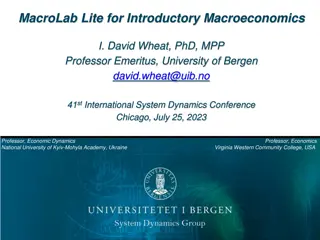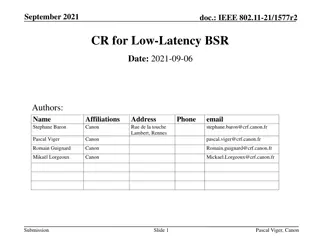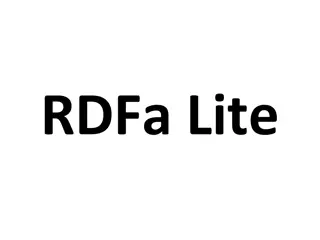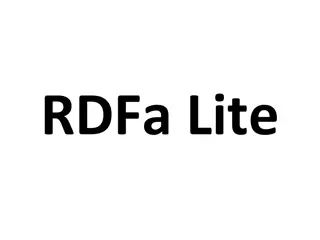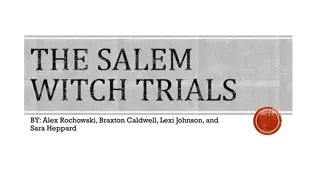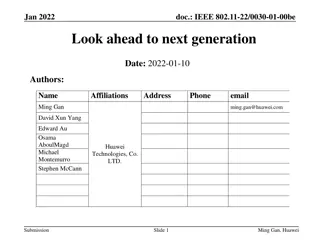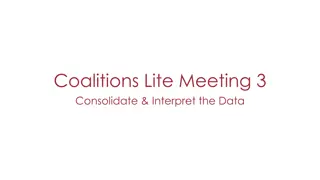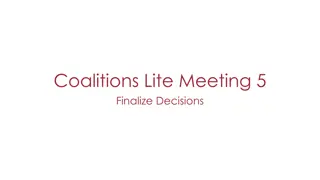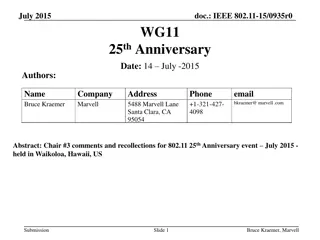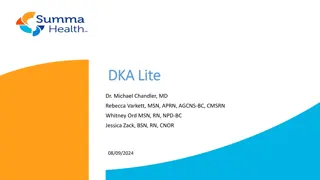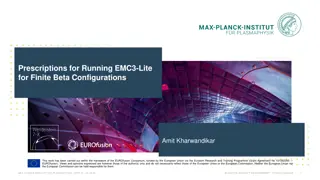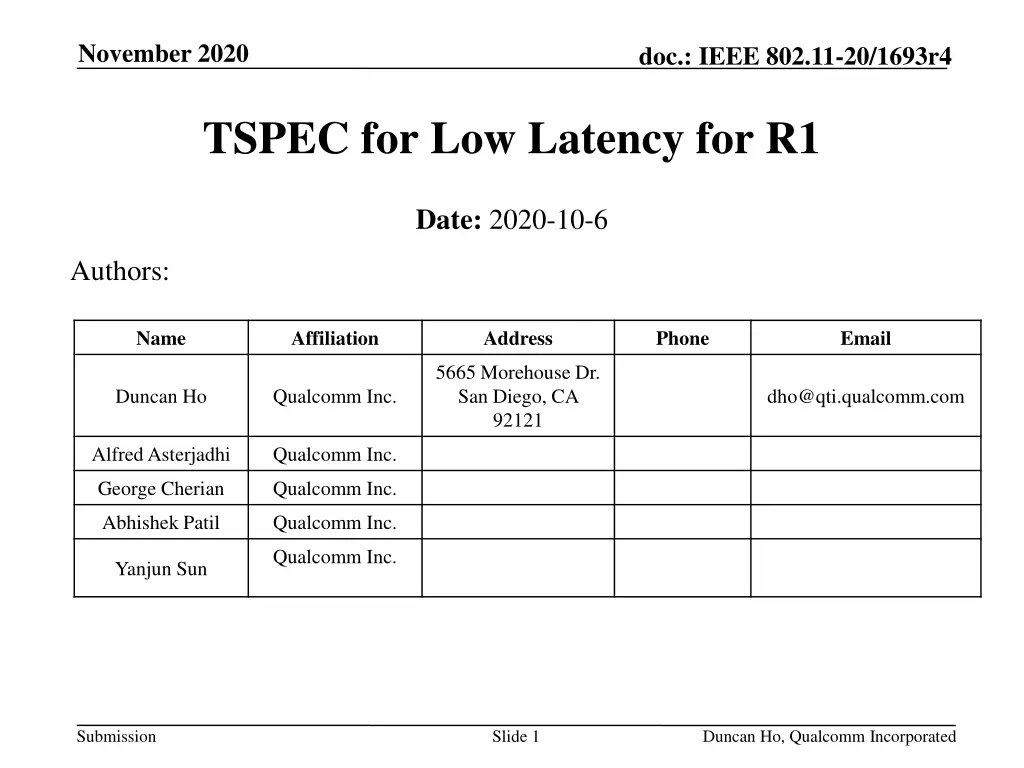
IEEE 802.11-20/1693r4 TSPEC Element and Proposals Overview
Explore the IEEE 802.11-20/1693r4 TSPEC element and its crucial fields for 11be implementation. Learn about defining a new IE with specific properties like traffic patterns, QoS requirements, and more. Discover the relevance of TSPEC in conveying traffic characteristics and expectations in wireless communication systems.
Download Presentation

Please find below an Image/Link to download the presentation.
The content on the website is provided AS IS for your information and personal use only. It may not be sold, licensed, or shared on other websites without obtaining consent from the author. If you encounter any issues during the download, it is possible that the publisher has removed the file from their server.
You are allowed to download the files provided on this website for personal or commercial use, subject to the condition that they are used lawfully. All files are the property of their respective owners.
The content on the website is provided AS IS for your information and personal use only. It may not be sold, licensed, or shared on other websites without obtaining consent from the author.
E N D
Presentation Transcript
November 2020 doc.: IEEE 802.11-20/1693r4 TSPEC for Low Latency for R1 Date: 2020-10-6 Authors: Name Affiliation Address Phone Email 5665 Morehouse Dr. San Diego, CA 92121 Duncan Ho Qualcomm Inc. dho@qti.qualcomm.com Alfred Asterjadhi Qualcomm Inc. George Cherian Qualcomm Inc. Abhishek Patil Qualcomm Inc. Qualcomm Inc. Yanjun Sun Submission Slide 1 Duncan Ho, Qualcomm Incorporated
doc.: IEEE 802.11-20/1693r4 Intro For a STA of a non-AP MLD to request low latency service, the STA needs to convey its expected traffic pattern and QoS requirements to the AP To provide this information we can leverage the existing TSPEC defined in 802.11 Submission Slide 2 Duncan Ho, Qualcomm Incorporated
doc.: IEEE 802.11-20/1693r4 What is a TSPEC Element? The TSPEC element contains the set of parameters that define the characteristics and QoS expectations of a traffic flow, in the context of a particular STA, for use by the HC or PCP and STA(s) or a mesh STA and its peer mesh STAs in support of QoS traffic transfer using the procedures defined in 11.4 (TS operation) and 11.22.16.3 (GCR procedures). Submission Slide 3 Duncan Ho, Qualcomm Incorporated
doc.: IEEE 802.11-20/1693r4 TSPEC Element TSPEC has 28 fields - 57 or 59 octets There are a lot of fields. Do we need all of them for 11be? We highlighted 14 fields that we think are useful for 11be Nominal MSDU Size Maximum MSDU Size Minimum Service Interval Maximum Service Interval Element ID Length(#4 056) Inactivity Interval Suspension Interval TS Info Octets: 1 1 3 2 2 4 4 4 4 Surplus Bandwidth Allowance Service Start Time Minimum Data Rate Mean Data Rate Peak Dat a Rate Delay Bound Minimum PHY Rate Medium Time DMG Attributes Burst Size Octets: 4 4 4 4 4 4 4 2 2 0 or 2 Figure 9-298 TSPEC element format B0 B1 B4 B5 B6 B7 B8 B9 B10 B11 B13 B14 B15 B16 B17 B23 TS Info Ack Policy Traffic Type Access Policy User - Priority TSID Direction Aggregation APSD Schedule Reserved Bits: 1 4 2 2 1 1 3 2 1 7 TS Info field format Submission Slide 4 Duncan Ho, Qualcomm Incorporated
doc.: IEEE 802.11-20/1693r4 Proposals Define a new IE* (e.g., TSPEC-lite) that has the following properties: Indicates expected traffic pattern and QoS requirement of a TID in a specific traffic direction The traffic can be periodic or aperiodic Contains a subset of fields of the TSPEC IE and some new fields (e.g., Age to discard) Can be included as an IE in other MGMT frames (e.g., TWT Request, TID-to-Link Mapping/ML setup, etc.) Not coupled with AddTS and the original TSPEC Extensible (note: original TSPEC element is not extensible for non-DMG STAs) Includes a TID bitmap to indicate which TID(s) the same parameters apply to (i.e., same parameters in the TSPEC-lite will be applied to all indicated TIDs) The AP can serve the TIDs independently according to the parameters Note: We can still use TSPEC IE, and make it extensible, since it is sent to STAs supporting reception. Submission Slide 5 Duncan Ho, Qualcomm Incorporated
doc.: IEEE 802.11-20/1693r4 TSPEC-lite Fields Field Name Element ID (1 octet), Element ID Extension (1 octet) Length (1 octet) Definition (shortened) Element ID, Element ID Extension set by <ANA> Notes Basics Length of the payload Basics TID Bitmap (1 octet) The TID Bitmap specifies which TIDs the element applies to. If the bit position corresponding to the TID value is set to 1, this elements apply to that TID. One or more bits can be set to 1. The Direction subfield specifies the direction of data carried by the TS as defined in Table 9-160 indicating: UL, DL, Direct link, Symmetrical bi-directional link. New field Direction (2 bits) Inherited from TSPEC Minimum Service Interval The Minimum Service Interval field (#4696)contains an unsigned integer that specifies the minimum interval, in microseconds, between the start of two successive SPs. Inherited from TSPEC (4 octets) Maximum Service Interval The Maximum Service Interval field (#4696)contains an unsigned integer that, when the TSPEC element is for the admitting of HCCA streams, specifies the maximum interval, in microseconds, between the start of two successive SPs. The Inactivity Interval field contains an unsigned integer that specifies the minimum amount of time, in microseconds, that can elapse without arrival or transfer of an MPDU belonging to the TS before this TS is deleted by the MAC entity at the HC. The Suspension Interval field contains an unsigned integer that specifies the minimum amount of time, in microseconds, that can elapse without arrival or transfer of an MSDU belonging to the TS before the generation of successive QoS(+)CF-Poll is stopped for this TS. The Service Start Time field contains an unsigned integer that specifies the time, expressed in microseconds, when the first scheduled SP starts. The service start time indicates to the AP the time when a STA first expects to be ready to send frames and a power saving STA needs to be awake to receive frames. Inherited from TSPEC (4 octets) Inactivity Interval (4 octets) Inherited from TSPEC Suspension Interval (4 octets) Inherited from TSPEC Service Start time (4 octets) Inherited from TSPEC Submission Slide 6 Duncan Ho, Qualcomm Incorporated
doc.: IEEE 802.11-20/1693r4 The TSPEC-lite Fields Field Name Minimum Data Rate Definition (shortened) The lowest data rate specified at the MAC SAP, for transport of MSDUs or A-MSDUs belonging to this TS Notes Inherited from TSPEC (4 octets) Mean Data Rate The average data rate specified at the MAC SAP, for transport of MSDUs or A-MSDUs belonging to this TS Inherited from TSPEC (4 octets) Burst Size The Burst Size field contains an unsigned integer that specifies the maximum burst, in octets, of the MSDUs or A-MSDUs belonging to this TS that arrive at the MAC SAP at the peak data rate. Unsigned integer that specifies the maximum amount of time, in microseconds, allowed to transport an MSDU or A-MSDU belonging to the TS in this TSPEC, measured between the time marking the arrival of the MSDU, or the first MSDU of the MSDUs constituting an A- MSDU, at the local MAC sublayer from the local MAC SAP and the time of completion of the successful transmission or retransmission of the MSDU or A-MSDU to the destination. The completion of the MSDU or A-MSDU transmission includes the relevant acknowledgment frame transmission time, if present. Inherited from TSPEC Delay Bound (4 octets) Inherited from TSPEC Discard Age (2 octets) Unsigned integer that specifies the maximum age of an MSDU, in milliseconds, after which the transmitter shall discard the MSDU. New field Submission Slide 7 Duncan Ho, Qualcomm Incorporated
doc.: IEEE 802.11-20/1693r4 Further Optimization Since some of the fields will carry redundant info if sent together with a TWT Request, we can make these fields optional Submission Slide 8 Duncan Ho, Qualcomm Incorporated
doc.: IEEE 802.11-20/1693r4 SP1 Do you agree to add the following to 11be R1: An AP or non-AP MLD shall use a variant of the TSPEC IE as part of the QoS signaling to define the application-session level characteristics and QoS expectations of a traffic flow Note 1: traffic characteristics refers to description of the traffic that can be extracted from applications/higher layers Submission Slide 9 Duncan Ho, Qualcomm Incorporated
doc.: IEEE 802.11-20/1693r4 SP2 Do you agree to add the following to 11be R1: If MLD intends to provide QoS parameters for delay-sensitive traffic using SCS, then the SCS Request/Response frame shall include the TSPEC variant element: The UP field of such TSPEC variant element is reserved The TWT Setup frames may include the TSPEC variant element or the SCSID for an established SCS session The TSID field of such TSPEC variant element sent by an EHT STA shall be set to a value between 0 to 7 (i.e., TID value 0-7) Note: A TSPEC variant element is a modified version of the TSPEC element Note: The TSID field is used to carry the TID value (0-7) Submission Slide 10 Duncan Ho, Qualcomm Incorporated
doc.: IEEE 802.11-20/1693r4 SP3 Do you agree to add the following to 11be R1 : The new IE shall contain at least the following fields, some from the TSPEC element: Traffic Type (inherited from TSPEC) TSID (inherited from TSPEC) Direction (inherited from TSPEC) User Priority (inherited from TSPEC) TID (value 0-7) Minimum Service Interval (inherited from TSPEC) Maximum Service Interval (inherited from TSPEC) Inactivity Interval (inherited from TSPEC) Suspension Interval (inherited from TSPEC) Service Start time (inherited from TSPEC) Minimum Data Rate (inherited from TSPEC) Mean Data Rate (inherited from TSPEC) Burst Size (inherited from TSPEC) Delay Bound (inherited from TSPEC) Packet delivery ratio (percentage of packets delivered that were within the delay bound specified in Delay Bound) Notes: The traffic flow can be between two non-AP MLDs TBD if more fields are needed Submission Slide 11 Duncan Ho, Qualcomm Incorporated
doc.: IEEE 802.11-20/1693r4 SP4 Do you agree to add the following to 11be R1 : If the TSPEC IE contained within a TWT request frame, then some of the TSPEC fields that have equivalent fields in the TWT IE may be omitted ? Submission Slide 12 Duncan Ho, Qualcomm Incorporated


